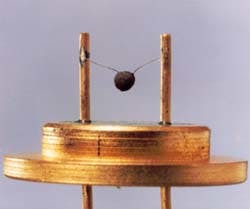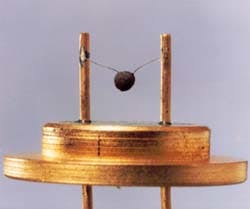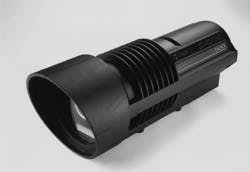GAS DETECTION Infrared sensors broaden scope of platform gas analysis
Jeff Markley
Zellweger Analytics
(Left) Catalytic detectors reveal the presence of combustible gases through a change in the resistance of the embedded coil - but their sensitivity can be affected by airborne contaminants. (Right) Infrared sensors allow open path detectors such as Sieger's Searchline 500 to detect gas up to 200 metres away.
If you will pardon the pun, the last five years have seen an explosion in the use of infrared gas detection in offshore applications. From being seen as a technique to be employed as a last resort in specific applications, infrared sensors are now considered normal for the detection of hydrocarbon gases on offshore installations. The reasons for this trend are many, but centre around changing customer requirements and the development of more cost-effective and practical devices by the manufacturers.
Before infrared techniques became common, the main technology used for hydrocarbon detection was the still popular `catalytic' detector. This relied on the measurement of a change in electrical resistance of a platinum coil embedded in a catalyst. Any combustible gas present would react exothermically with oxygen in the air and heat up the catalyst, causing a change in resistance in the embedded coil.
Devices based on this technology have been around for nearly 40 years, and are generally low cost and reliable. For offshore applications, however, they suffer from two main drawbacks. Firstly, they have a lower response to heavy hydrocarbons than, say, methane, and secondly they suffer from what is known as `poisoning'.
Poisoning is the loss of activity of the catalyst caused by airborne contaminants such as silicone vapors. This means that poisoned sensors give a reduced output in response to a gas leak, leading to a possibly dangerous situation.
Although modern devices have excellent poison resistance, this characteristic results in a high maintenance demand for regular calibration checks. In these days of not normally manned platforms, CRINE and other efforts to increase efficiency, such a requirement cannot be looked on favorably.
Infrared technology, by contrast, is purely physical in nature, relying on the absorption of selected wavelengths of light by the hydrocarbon gases. Sensors based on this principle have a source of light and a light detector. If gas intervenes between the two, the level of light falling on the detector is reduced, and this can be continuously monitored.
Clearly this technique removes the possibility of poisoning, and the laws of physics also mean that the output to heavier hydrocarbons is generally greater than that of methane.
The latest products include very sophisticated optical design and signal processing software, making a device which can be factory calibrated and which therefore uses self compensation to maintain zero and calibration stability - a theoretically maintenance-free device which will give a warning should any fault develop. Advantages for offshore applications are self-evident.
In addition, infrared sensors can be made to detect gas not only at a given point, but by projecting a beam of light from a source to a detector - possibly via a reflector - can detect gas over a distance of between 1 and 200 metres.
These so-called open path detectors have a huge advantage in practical applications: they generally have very fast response times and also measure the total amount of gas in the beam, rather than the concentration at a particular point. This means that a gas release which has been dispersed by wind or natural diffusion can still be detected, even though its actual point concentration may have fallen below normal alarm settings.
For example, Chevron used Sieger Searchline open path detectors to monitor emergency shutdown valves under the cellar deck on Ninian Central in the UK North Sea. This gave protection in a very exposed location where point detectors would have been of limited value. The low maintenance requirements were also of particular interest due to the difficulty of getting access to the devices on a routine basis.
For infrared point detectors, the new Sieger Searchpoint Optima detector was, in the best spirit of CRINE philosophy, developed in conjunction with so-called `customer partners' from the main offshore users. User input has resulted in a cost-effective design which already had proven performance in offshore testing, prior to its launch.
This has benefited end-users, who could obtain the latest technology without reliability concerns: for example, Marathon Oil UK fitted the new detectors on its East Brae turbine enclosures following a six-month trial of pre-production units as part of the customer partner project.
Manufacturers also benefit by getting a more rapid return on investment than would normally be possible. This last point is vital if such high investment projects are to be viable: Searchpoint Optima was the first new product from Zellweger Aanalytics to exceed a &163;1 million development budget.
This co-operation between customer and manufacturer looks likely to be a key feature of future developments in the gas detection field. The obvious requirements of yet further reductions in size, weight and cost will no doubt feature in the next generation of products.
However, the latest products meet most requirements in this respect already, and there is clearly a law of diminishing returns that will apply. What we are likely to see is further development of infrared capability - such as improved toxic gas, oil mist and flame detection - plus yet further reductions in maintenance frequency and downstream cost of ownership.
Copyright 1995 Offshore. All Rights Reserved.


